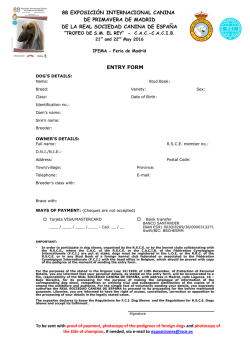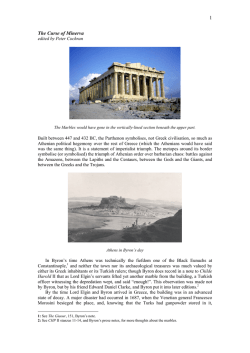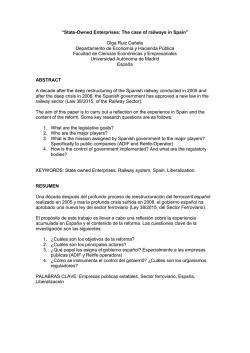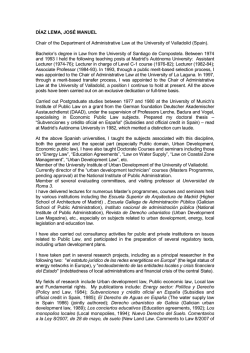
Maquetación 1 - Sociedad Geológica de España
107 Revista de la Sociedad Geológica de España 29 (2) ISSN (versión impresa): 0214-2708 ISSN (Internet): 2255-1379 MAJOR SCALE STRUCTURE OF THE MARBLES SITUATED BETWEEN CÓBDAR AND MACAEL (NEVADO-FILÁBRIDE COMPLEX, BETIC CORDILLERA, ALMERÍA PROVINCE, SPAIN), AND GENERAL STRATIGRAPHIC ARRANGEMENT Cartografía de los mármoles situados entre Cóbdar y Macael (Complejo Nevado-Filábride, Cordillera Bética, provincia de Almería, España), y sucesión estratigráfica general Carlos Sanz de Galdeano1, Ángel C. López Garrido1 and Ángel Santamaría-López2 1Instituto Andaluz de Ciencias de la Tierra (IACT), (CSIC- Universidad de Granada), Facultad de Ciencias, 18071 Granada, Spain. [email protected], [email protected]. 2Departamento de Química Inorgánica, Cristalografía y Mineralogía, Facultad de Ciencias, Universidad de Málaga, 29071 Málaga, Spain. [email protected]. Resumen: En el área situada entre las localidades de Cóbdar y Macael se encuentra uno de los mejores afloramientos de la formación de esquistos y mármoles correspondiente a la parte superior de la secuencia litológica del Nevado-Filábride. En ella se definieron varias unidades tectónicas, basadas en diferencias metamórficas, y también se ha considerado que toda la secuencia está afectada por una amplia zona de cizalla. Sin embargo, el análisis de la estructura indica que el contacto inferior de la formación parece ser generalmente estratigráfico y parte del mismo está invertido, formando un apretado sinclinal con vergencia al NNE. La alternancia de mármoles y esquistos en el interior de la formación es en general coherente, con importantes pliegues en su parte superior, los cuales tienen la misma vergencia al NNE. En muchos puntos un nivel de mármoles se divide en otros varios o desaparece lateralmente, lo que suele ser progresivo, pasando los mármoles a ser calcoesquistos para finalmente desaparecer; en muchos casos los niveles cambian de espesor lateralmente. Los nuevos datos aportados parecen contradecir la existencia de las citadas unidades tectónicas y, al mismo tiempo, la interpretación de que constituya una compleja zona de cizalla separada de una unidad inferior por un contacto de manto. Palabras clave: Cordillera Bética, Zona Interna, Nevado-Filábride, pliegues. Abstract: In the area situated between the localities of Cóbdar and Macael appears one of the best outcrops of the formation of schists and marbles situated in the upper part of the Nevado-Filábride lithological succession. In this sector, several tectonic units were defined, based in metamorphic differences, and also, this formation has been considered as forming a wide shear zone separated by a thrust contact from a lower unit. Our macro scale structural analysis points that the basal contact of the formation seems to be stratigraphic and is partially reversed, describing a NNE verging recumbent synform. The alternation of schists and marbles within the formation is generally well exposed, also with NNE verging folds of minor size, although in the upper part of the formation these folds are larger in several points. Levels of marbles laterally divide in many others or grade to calcschist and then disappear. These data seems to contradict the existence of the above-cited units and that of a general wide shear zone. Key-words: Betic Cordillera, Internal Zone, Nevado-Filábride, folds. Sanz de Galdeano, C, López Garrido, A.C. and Santamaría-López, A. (2016): Major scale structure of the marbles situated between Cóbdar and Macael (Nevado-Filábride Complex, Betic Cordillera, Almeria province Spain), and general stratigraphic arrangement. Revista de la Sociedad Geológica de España, 29(2): 107-116. Revista de la Sociedad Geológica de España, 29(2), 2016 108 THE MARBLES OF CÓBDAR - MACAEL AREA The present differentiation of tectonic units in the Nevado-Filábride Complex is based mainly on interpretations given to explain the different degrees of metamorphism found at different heights in the lithologic succession. These interpretations make it necessary, in some cases, to situate tectonic contacts, detachments or ductile shear zones. Consequently, as the metamorphic data progressively changed along the time, also has changed the number and even the boundaries of the units. This is important because the existence or not of any particular unit determines part of the interpretation of the geologic evolution of the Nevado-Filábride Complex. This has happened particularly within the Nevado-Filábride marbles, situated in the upper part of the lithologic succession of this complex, which have been interpreted in very different ways as is indicated in the background. By the contrary, in our opinion detailed cartographies and real controls of the lithological successions, taking also into account the former stratigraphic relations, are largely missing. These aspects are necessary data permitting to accept or to reject some of the previously proposed tectonic interpretations. Geological setting The Betic Cordillera is divided into External and Internal Zones (Fig. 1A), and furthermore into the Flysch units and the Neogene basins (Durand-Delga and Fontboté, 1980). The External Zone corresponds to the sedimentary Mesozoic and Tertiary cover of the S and SE border of the Iberian Paleozoic Meseta, and according to its greater or lesser proximity to this Meseta and the character of its stratigraphic successions it is subdivided into Prebetic (usually with shallow and neritic sediments) and Subbetic (usually pelagic) (Vera, 1988). The Internal Zone is divided in four complexes that from bottom to top are: the Nevado-Filábride, the Alpujarride, the Malaguide and, closely related to the latter, the Dorsal. Nevado-Filabride and the Alpujarride complexes (Fig. 1B) were metamorphosed during Alpine orogeny, then forming their present structure. These two complexes present Palaeozoic and Triassic successions. The existence of Jurassic and younger successions is at the moment debatable. On the contrary, the Malaguide Complex, which presents wide Palaeozoic and locally Mesozoic and Tertiary outcrops, was only slightly affected by the Alpine metamorphism. Meanwhile, the Dorsal, formed by Mesozoic and Tertiary sediments, was also structured during the Alpine period and is generally not metamorphosed. The present study focuses on the tectonically lower complex, the Nevado-Filabride. This complex appears only in the Betic Cordillera, while the other three complexes also exist in the Rif Cordillera, directly situated to the south, on the northern border of Morocco. Background Among the old papers describing the sierras Filabres and Nevada, the article of Brouwer (1926) is probably the most Revista de la Sociedad Geológica de España, 29(2), 2016 important. This author differentiated two great formations in the "Penninic Betics", as he called the Nevado-Filábride Complex. The lower one, the "Crystalline of Sierra Nevada" (Kristallijne Schisten), formed by a monotonous succession of mica schists with graphite and quartzites, probably Palaeozoic, and the upper ensemble, the "Mixed Zone" (Mischungzone), formed by schists, quartzites, marbles, gneisses, serpentinites, and amphibolites. Egeler (1963) used the name of Nevado-Filábride Complex for the first time. He recognized the two formations defined by Brouwer (1926), although considering the possibility of the existence of several tectonic units. In the area of Lubrin (eastern part of Sierra Filabres, Fig. 1B) Nijhuis (1964) distinguished three tectonic units that from bottom to top are the Nevado-Lubrin (the Crystalline of the Sierra Nevada), the Chive, and the Bedar units, with ages spanning the Pre-Permian to the Triassic and, as he indicated, “younger ages?”. This work probably constitutes the first in which the Mischungzone is divided in tectonic units. Helmers and Voet (1967) distinguished more units in the central and eastern parts of the Sierra de los Filabres. According to these authors, the units are, from bottom to top, the Nevado-Lubrin, the Secano, the ChiveMacael, the Bedar, and the Almocaizar units. This division, although eliminating the Secano unit, is followed by Egeler and Simon (1969). In Sierra Nevada, Puga (1971) and Puga et al. (1974) distinguished two great nappes, the Veleta and the Mulhacen. The Veleta nappe is almost equivalent to the Crystalline of the Sierra Nevada and the Mulhacen nappe to the Mischungzone, although locally part of the Crystalline of the Sierra Nevada is attributed to this last nappe. On the contrary, Galindo-Zaldívar (1993), studying the central and western part of Sierra Nevada, found no tectonic contact (detachments or ductile shear zones) either between the previously described Veleta and Mulhacen nappes, or in lower positions within the Veleta nappe. For this reason, he considered the entire Nevado-Filábride Complex to be a single ensemble. Gómez Pugnaire et al. (2000, 2004, 2012) showed a continuous lithostratigraphic succession of the NevadoFilábride formed by the superposition of different units. In this sequence the rocks are progressive and steadily younger to the top. López Sánchez-Vizcaíno et al. (2001), describing the exhumation of the Nevado-Filábride, considered the rocks of this complex as a simple lithologic succession. According to these authors, the contact between the corresponding position to the contact between the Veleta and Mulhacen units is marked by an erosion surface, overlaid by conglomerates. Martínez-Martínez et al. (2002) changed the name of the Veleta nappe to the Ragua unit, and used the names of Calar Alto (instead that of Mulhacen) and Bedar-Macael units for the upper units that they consider. The difference with the names of Veleta and Mulhacen is justified because the Calar Alto unit should occupy part of the top formerly attributed to the Veleta nappe. The structure of the marbles of Cóbdar-Macael has been described in quite different ways: the first articles considered Carlos Sanz de Galdeano, Ángel C. López Garrido and Ángel Santamaría-López them as forming only the upper part of the lithologic succession of the Nevado-Filábride (as did Brouwer, 1926) while later they were differentiated into several tectonic units, separated by thrusts, as did Helmers and Voet (1967). García-Monzón et al. (1975) and Kampschuur (1975) differentiated within these marbles, from bottom to top, the Bedar-Macael, Almocaizar, and other upper units, all being separated by thrust surfaces. A similar differentiation of units was proposed by Linthout and Vissers (1979) who distinguished in these marbles, and from bottom to top, the Umbria de las Canteras, Macael, and Huertecicas units. This latter distribution of units was followed by Weijermars (1991). De Jong (1993) considered the marbles of CóbdarMacael as having been formed by the tectonic units, from bottom to top, of Macael-Chive, and Huertecicas Altas -Almocaizar. Within these units this author described several formations of marbles. In the previous cited works the Nevado-Lubrin and Secano units, generally not presenting marbles, should be situated in the bottom. 109 Booth-Rea et al. (2015) included the marbles of Cóbdar-Macael in the Bedar-Macael nappe, a nappe that in their opinion was entirely affected by a wide shear zone (the Marchal shear zone) submitted to ductile deformations, under amphibolitic conditions; this nappe is situated over the Calar Alto unit. They did not consider the above-cited differentiation in units or nappes. Until the present days the differentiation in units of the Cóbdar-Macael marbles, or even the disregard of these units, has been supported only by very general maps, with the exception of that of García-Monzón et al. (1975), which corresponds to the 1:50000 scale geologic map of these area. Age attributions García-Monzón et al. (1975) considered the age of the Tahal Fm (described in the next section) as possibly middle Triassic or older. In gneisses existing in the formation of schists and marbles (see the next section) Priem et al. Fig. 1.- A: Geological scheme of the Betic Cordillera. The inset indicates the position of B. B: Sketch map of the distribution of the lithologic formations of the Nevado-Filabride Complex in the sierras Nevada and Filabres. The inset indicates the position of Figure 2. Revista de la Sociedad Geológica de España, 29(2), 2016 110 THE MARBLES OF CÓBDAR - MACAEL AREA Fig. 2.- Simplified geological map of the area situated between Cóbdar and Macael. The position of the cross sections of Figure 4 is indicated. The asterisk marks the position of the sample that gave a possible Cretaceous age. The approximate position of the photos of Figure 6 is marked with red circles and numbers. (1966) proposed an age of 275 ± 30 Ma., Andriessen et al. (1991) indicated an age of 267 ± 29 Ma, Martínez-Martínez et al. (2010) dated them from 304±23 Ma to 319.85±5.81, and Gómez-Pugnaire et al. (2012) calculated an age of 292 ± 3 Ma. These ages span the Late Carboniferous to Early Permian. Moreover, there is a proposal of a Cretaceous age: Tendero et al. (1993) found possible foraminifers that recall some Cretaceous (Turonian) forms. According to this article, they were found in a sample taken in marbles, approximately 1 km NNE of Cóbdar (the asterisk in Fig. 2). It will be of interest if this proposal is confirmed. Finally, Portugal et al. (1988) estimated an age of 174±4 Ma and 164±4 Ma (Middle and Upper Jurassic) for the metabasites of Cóbdar. Aim of the article The main objective of this paper is to present a more detailed map (Fig. 2), originally made to a 1:25000 scale. Revista de la Sociedad Geológica de España, 29(2), 2016 Afterwards, with this map, some features concerning the existence or not of the above-cited units can be discussed and deduced, giving important keys to the understanding and study of this metamorphic area. Main characteristics of the Nevado-Filábride Complex lithologic succession in the area of Cóbdar-Macael The following description of the rocks forming the lithologic succession cropping out in the study area refers to their field characteristics. For the petrologic aspects it is useful to read the above-cited articles, in which the descriptions are generally accurate (for instance García-Monzón et al. 1975; de Jong, 1993; Gómez-Pugnaire et al., 2000, 2012; Booth-Rea et al., 2015). In this area only the upper part of the NevadoFilábride lithologic succession (Fig. 3) is present, while the lower part, the Crystalline of Sierra Nevada, crops out 7 km to the SW. The Tahal Formation Carlos Sanz de Galdeano, Ángel C. López Garrido and Ángel Santamaría-López Over the Crystalline of Sierra Nevada a formation (Tahal Fm from Nijhuis, 1964) of mica schists with garnets and quartzites intercalated, crops out. To the south of the study area, not in it, there is a thick band of quartzites -the Benitagla quartzites as we call them- situated over the Crystalline of Sierra Nevada. Generally, and in particular in the study area, the size of the garnets and other metamorphic minerals visible in the schists varies depending on the layers (in some ones the garnets can reach more than 5 mm, while in adjacent layers they can be very small or even are not visible in the field). In the study area the size of minerals changes laterally, enlarging progressively westwards (the greater size is particularly visible in the road from Macael to Tahal towns). These schists are generally grey, varying from light to dark tones. At some points the white mica is very abundant and the rock can be considered to be a micacite. In this area, the Tahal Fm is more than several hundred metres thick. In the upper part of this formation, thin layers of marbles and calc-schists alternate with the schists. The schists and marbles formation Above the Tahal Fm is situated the main succession of marbles, always alternating with schists. The marbles are distributed forming different layers of variable thicknesses and lengths (see Fig. 2). In some cases the layers are more than 15 m thick, while in others no more than several centimetres. In some cases marbles laterally disappear, generally changing previously to calc-schist. Moreover, in many cases one single level laterally splays into several others. The metadetrital rocks appear as an alternation of schists (generally light-grey coloured, but there are also some dark-grey levels), micacites, and quartzites. The appearance of rich garnet layers is common. The size of the garnet varies (from several centimetres to millimetres) between levels and into the same level. In one sector situated between the localities of Cóbdar and Lijar some layers of the metadetritic rocks contain porphyroblasts of feldspar, that laterally disappear passing to mica schists with garnets. Due to these constant variations, the traces of the layers, marbles or schists, can be only approximated drawn in the cartography. In fact, many thick levels 111 of apparently continuous marbles or schists, when cut in a quarry show that they contain int ercalations of schists or marbles. Considering the dip of the layers and their distribution in the cartography, the total thickness of the schists and marbles exceeds 1 km. The main part of this thickness corresponds to the schists, as can be seen in the cross sections of Figure 4. Interbedded with the previous formations there are metabasites and, more locally, gneisses. The metabasites are particularly abundant in the upper part of the Tahal Fm arrayed in different bodies, but they also exist within the upper formation of schists and marbles. When these bodies are thin, the usual aspect of these metabasites is that of the amphibolites, but where they are thick, in its interior the original rock conserves its original texture (feldspars totally disoriented). The rocks cropping out in the area of Cóbdar were studied by Puga et al. (1990), who interpreted them as remains of a Jurassic ocean floor. Nevertheless, it bears noting that many of the outcrops of these metabasites are very thin, probably corresponding only to lavas, not to oceanic floor fragments. Figure 2 marks only approximately the position of the metabasites. Fig. 3.- Synthetic lithologic succession of the Nevado-Filábride Complex in the study area. Some formations not present in this area, but situated not very far, are indicated without colour. This figure cannot express great number of details, as the profusion of intercalations of the different types of rocks. Revista de la Sociedad Geológica de España, 29(2), 2016 112 THE MARBLES OF CÓBDAR - MACAEL AREA In the area of Cóbdar-Macael, orthogneisses are not abundant, and only one outcrop has been situated in Figure 2. In other places, together with the highest levels of marbles, there are cinerites. Locally there are thick colluvial deposits, in many cases not indicated in Figure 2. Moreover, in the sectors where quarries developed (south of Macael), many dump areas completely cover the underlying rocks and structures. The lithologic succession of the Alpujarride outcrops has not been differentiated in the figures. They correspond to schists, phyllites, and marbles, locally with abundant gypsum, generally easily distinguishable from the Nevado-Filábride rocks. In the area of Lijar, both the Nevado-Filábride and the Alpujarride complexes are partially covered by sediments of the upper Neogene. It is worth mentioning that 2 km northward of Lijar the map of García-Monzón et al. (1975) indicates a major thrust of Nevado-Filábride rocks over the Alpujarride Complex. However, these rocks, although of Nevado-Filábride origin, are breccias and conglomerates, disposed in an alluvial cone formed during the upper Neogene. That is, this thrust really does not exist. The main data of the structure are showed in Figures 2 and 4 to 6. In general, the alternation between the schists and marbles is clear and can be followed for kilometres (Figs. 4 and 5). Only to the S of Macael this alternation is less visible because the dip of the layers diminishes and they cannot be separated clearly on a map, although they are visible in the slopes of the valleys. The most interesting structures observed are situated in the lower marbles, in the contact with the Tahal Fm, and in the upper marbles. In the lower ones the synclinal existing W of Cóbdar (Fig. 4, cross section 4) is particularly noteworthy. In this area, the marbles dip southwards, passing The Alpujarride Complex and other types of rocks Major scale structure of the schists and marbles formation between Cóbdar and Macael Fig. 4.- Geologic cross sections of the schists and marbles formation of the Nevado-Filábride Complex in the area of Cóbdar-Macael. Their locations are indicated in Figure 2. Revista de la Sociedad Geológica de España, 29(2), 2016 Carlos Sanz de Galdeano, Ángel C. López Garrido and Ángel Santamaría-López 113 Fig. 5.- Panoramic view of the middle and upper part of the formation of schists and marbles, showing the alternation of generally parallel layers. In the central part of the figure there are apparent folds, but this disposition in fact corresponds to the intersection with the topography, not to real folds. Note the general tendency to present a lower dip to the N. Southwards the alternation of schists and marbles continues. This panoramic view is located between cross sections 3 and 4, the northern extreme situated directly to the south of Líjar. under the schists of the Tahal Fm (Figure 6.1), while in the Cóbdar locality these schists are situated under the marbles. This structure corresponds to a synclinal with a NNE vergence which nucleus is partially visible in the quarries of the area (Fig. 6.2), there affecting a higher level of schists. The vergence is to the NNE. This very tight structure laterally disappears, shifting the marbles to overlie the schists (Fig. 4, cross sections 1 to 3). The upper marbles bear two points of interest, where major folds, also verging northwards, are visible. The first point (Fig. 6.3) is situated near to the cross section 3 of Figure 4 but, laterally, the folds there existing have been eroded and disappear. The other point is situated to the W of Lijar (Fig. 6.4). In the interior of the formation of schists and marbles the visible array of layers of schists and marbles is generally simpler, as can be seen in Figure 5 (although also exist local tight folds of the same NNE vergence). With several exceptions, the dip of the layers diminishes progressively northwards. This formation of schists and marbles is overthrust by the Alpujarride Complex. This thrust is situated in the higher parts of the cited formation, but not always in the same position, as it presents a footwall ramp geometry. In addition to the above-described structures, small folds striking N20ºE-S20ºW can locally be seen. These folds do not significantly disturb the general structure described above, but perhaps are related with several reverse faults drawn in Figure 2, visible near the localities of Cóbdar and Lijar. One of these reverse faults, situated 2.5 km to the west of Lijar, locally thrusts the Nevado-Filábride over the Alpujarride Complex. Moreover, locally there are normal faults. Internal deformation mechanisms are visible in marble layers, showing internal tight folds, in some cases jointly affecting several layers. There are also even recumbent folds, visible in the quarries situated to the SSE of Macael. These folds were described by Zevenhuizen (1989), although in our opinion they present NE vergency, not SW as claimed by this author. There are, moreover, many other structures, such as boudins. These latter forms are abundant in marbles situated between schists or even within the marbles themselves, as it sufficient for their formation that the composition of the marbles varies slightly. Discussion One of the topics under discussion is the relation between the schists of the Tahal Fm and the schists and marbles formation. According to García-Monzón et al. (1975), in this contact the marbles overthrust the aforementioned schists. This interpretation is compatible with that observed Revista de la Sociedad Geológica de España, 29(2), 2016 114 THE MARBLES OF CÓBDAR - MACAEL AREA along most of the contact trace, because generally the marbles overlie the schists; however, W of Cóbdar, the marbles clearly underlie the schists (see Fig. 6.1). Although this arrangement is clearly visible for more than 1 km, the above-cited authors, and others included in the background section, maintain the existence of a thrust, against the field evidence. More to the W, the dip changes, and the schists and marbles formation is situated over the schists of the Tahal Fm In this case, in many places it is possible to see that the transition between the two types of rocks is assured by the presence of calc-schists situated in between. Moreover, this transition consists rarely of a single contact between the schists of the Tahal Fm and an initial major level of marbles. Usually there are several thin levels of marbles intercalated, before the appearance of the first thick level of marbles. We interpret this disposition as purely stratigraphic, assuring a concordant transition. These data, together with the general structure described, lead us to consider that the previous differentiated units are not real. Rather, this differentiation responded to a need: the previous authors found metamorphic differences between the schists intercalated in the marbles which they resolved by differentiating the units. A good example is the Secano unit, although is situated under the marbles. This unit was located in the area comprised by the southern end of cross sections 2 and 3 of Figure 4. In our interpretation, the reason of this differentiation was due to the fact that there the schists of the Tahal Fm bear large garnets and other minerals. However, it is possible to see that the size of these mineral decreases laterally, for instance SE-wards, in a progressive way (perhaps for this reason, Egeler and Simon, 1969, did not consider this unit). The same type of lateral changes is visible in the interior of the formation of schists and marbles. Fig. 6.- Structures visible in the study area. 1: Reversed contact between the higher layers of the schists of the Tahal Fm and the lower important layers of marbles of the upper formation of the Nevado-Filábride Complex. South dip of both lithological ensembles can be observed and is marked by three white arrows. This point is situated to the W of Cóbdar. 2: Detail of the nucleus of the recumbent syncline whose reverse flank is showed in 1. The schists visible in the photo corresponds to a lower layer included in the upper formation. It is visible in a quarry and can be partially followed laterally. 3: Panoramic view of folds situated near cross section 3 of Figure 4. The photo presents very different scale depending to the distance; to have an idea of the sizes consider that the high of the trees situated to the left in the river can reach, more or less, 10 m. 4: Folds situated approximately 2 km to the W of Lijar, in high layers of the marbles. White lines mark the position of layers; orange lines join contacts in sectors partially not visible; in 3, yellow lines mark the bottom of high important layers of marbles. The approximate position of these photos is marked in Figure 2. Revista de la Sociedad Geológica de España, 29(2), 2016 Carlos Sanz de Galdeano, Ángel C. López Garrido and Ángel Santamaría-López The interpretation of Booth-Rea et al. (2015) is simpler. These authors do not split this formation of schists and marbles into different units, but consider it as a wide shear zone (corresponding to the Bedar-Macael unit), tectonically separated from the Tahal schists, which should belong to the Calar Alto unit. But, according to the cartography presented in Figure 2, the general structure of the formation of marbles and schist is coherent, and, moreover, the contact with the Tahal Fm is not tectonic but stratigraphic one. This means that, in our opinion and at least in this area, the separation between the units, or nappes, of Calar Alto and Bedar-Macael is not supported by field data. We have indicated that the folds of the marbles and schists formation are better developed in its lower and higher parts. Probably this fact is controlled by the different rheology of the extremes (top and bottom) of the formation compared with its interior. There, in the interior, the alternation of schists and marbles is practically constant and relatively homogeneous, while in the extremes this alternation disappears: in the bottom the marbles are in contact with the schists of the Tahal Fm, while to the top, from the last thick layers of marbles the schists become highly dominant. This fact permits that the folds were more developed in the extremes while in the interior, although existing tight folds with the same vergence, usually are of smaller size. Another question is the aforementioned metamorphic differences. These differences are described in many articles, for instance in those indicated in the background section, and needs to be resolved. However, this is not the aim of the present study, this being only a call for making a better combination of cartographic, stratigraphic, tectonic, and petrologic studies. Future studies should not be limited to taking samples and, according to their results, then differentiate units and introduce tectonic contacts. This is particularly important because in adjacent layers it is common that the apparent degree of crystallinity was very different, and if this is forgotten the interpretations can be highly variable. Some lithologic, structural, and metamorphic controls exist, which should be better followed. The previous lines are included because we consider that many papers about Nevado-Filábride Complex are made without a real mapping study, the lithological lateral variations are not accurately controlled and many stratigraphical aspects are practically ignored. Studies on metamorphic areas of the Alpujarride Complex (García-Tortosa et al., 2000; Martín-Martín et al., 2006; Martín-Rojas et al., 2007), evidence that many tectonic contacts are actually stratigraphic contact related to changes in sedimentary realms. In our opinion this is the case of the study area. Finally, the environment where the metasediments, now constituting the formation of schists and marbles, were deposited could correspond to a marine littoral shallow platform (Permo?-Triassic in age). In this platform, sediments of clays, silts and sands were deposited, alternating in some places with carbonatic sediments, which relative distribution changed over time, producing the cited changes of the thickness of the layers of carbonates and its subdivisions in thinner layers. Conclusions 115 The data here presented indicate that the contact between the schists and marbles formation and the underlying schist of the Tahal Fm is stratigraphic and in the sector of Cóbdar it is reversed, with a recumbent synclinal existing there. Moreover, the alternation of schists and marbles in the formation is generally well exposed. It is common to see that the levels of marbles can be divided into many others, or laterally grade to calc-schists and even disappear. The structure of the interior of this formation is coherent and not particularly complex. Locally, in the upper part of this formation, there are also noticeable folds with a NNE vergence. This structure leads us to reject previous divisions of the formation of schists and marbles into several units: the possible tectonic contacts existing between the units in our opinion are not justified. On the other hand, this structure is well organized, not corresponding to an intricate wide shear zone, forming a separate unit from the schists of the Tahal Fm. This means that the problems existing with the difference of metamorphic degree must be studied taking into account also the cartographic, tectonic, and stratigraphic data, not using petrologic results alone. The present formation of schists and marbles probably corresponded to detrital and carbonatic sediments deposited in a wide shallow marine platform. Acknowledgments This study is one contribution of project CGL 201231872 (Ministerio de Economía y Competitividad, Spain) and the groups of research RNM- 370 and RNM 376 of the Junta de Andalucía. We are grateful to Prof. Martín-Martín and to an unknown reviewer, whose comments, suggestions and corrections clearly improved the manuscript. References Andriessen, P.A.M., Hebeda, E.H., Simon O.J. and Verschure, R.H. (1991): Tourmaline K-Ar ages compared to other radiometric dating systems in Alpine anatectic leucosomes and metamorphic rocks (Cyclades and southern Spain). Chemical Geology, 91: 33–48. Booth-Rea, G., Martínez-Martínez, J.M. and Giaconia, F. (2015): Continental subduction, intracrustal shortening and coeval uppercrustal extension: P-T evolution of subducted south-Iberian paleomargin metapelites (Betics, SE Spain). Tectonophysics, 663: 122–139. Doi: 10.1016/j.tecto.2015.08.036 Brouwer, H.A. (1926): Zur Tektonik der betischen Kordilleren. Geologische Rundschau, 17: 332–336. De Jong, K. (1993): Large-scale polyphase deformation of a coherent HP/LT metamorphic unit: the Mulhacen Complex in the eastern Sierra de los Filabres. Geologie en Mijnbouw, 71: 327–336. Durand-Delga, M. and Fontboté, J.M. (1980): Le cadre structural de la Méditerranée occidentale. 26 Congrès. Géol. Intern., Paris. Les Chaînes alpines issues de la Téthys. Mém. B.R.G.M., 115: 67–85. Egeler, C.G. (1963): On the tectonics of the eastern Betic Cordilleras. Geolgische Rundschau, LIII: 260–269. Egeler, C.G. and Simon, O.J. (1969): Sur la Tectonique de la Revista de la Sociedad Geológica de España, 29(2), 2016 116 THE MARBLES OF CÓBDAR - MACAEL AREA Zone Bétique (Cordillères Bétiques, Espagne). Verhandelingen der Koninklijke Nederlandse Akademie van Wetenschappen, 25, 3: 90 p. Galindo Zaldívar, J. (1993): Geometría de las deformaciones neógenas en Sierra Nevada (Cordilleras Béticas). Thesis Univ. Granada. Monografía Tierras del Sur, 249 p. García Monzón, G., Kampschuur, W. and Vissers, R. (1975): Mapa Geológico de España, e: 1:50.000, hoja 1013 (Macael), Instituto Geológico y Minero de España. Memoria de 43 p. García-Tortosa, F.J., López-Garrido A.C. and Sanz de Galdeano, C. (2000): Las unidades alpujárrides y maláguides entre Cabo Cope y Cabo de Palos (Murcia, España). Geogaceta, 28: 67–70. Gómez-Pugnaire, M.T., Galindo Zaldívar, J., Rubatto, D., González-Lodeiro, F., López Sánchez-Vizcaino, V. and Jabaloy, A. (2004): A reinterpretation of the Nevado–Filábride and Alpujárride Complexes (Betic Cordillera): field, petrography and U-Pb ages from orthogneisses (western Sierra Nevada, S Spain). Schweizerische Mineralogische und Petrographische Mitteilungen, 84: 303–322. Gómez-Pugnaire, M.T., Braga, J.C., Martín, J.M., Sassi, F.P. and Del Moro, A. (2000): Regional implications of a Palaeozoic age for the Nevado–Filábride Cover of the Betic Cordillera, Spain. Schweizerische Mineralogische und Petrographische Mitteilungen, 80: 45–52. Gómez-Pugnaire, M.T., Rubatto, D., Fernández-Soler, J.M., Jabaloy, A., López-Sánchez-Vizcaíno, V, González-Lodeiro, F., Galindo-Zaldívar, J. and Padrón-Navarta, J.A. (2012): Late Variscan magmatism in the Nevado-Filábride Complex: U-Pb geochronologic evidence for the pre-Mesozoic nature of the deepest Betic complex (SE Spain). Lithos, 146–147: 93–111. doi:10.1016/j.lithos.2012.03.027 Helmers, H. and Voet, H.W. (1967): Regional extension of the Nevado-Filábride nappes in the eastern and central Sierra de los Filabres (Betic Cordilleras, SE Spain). Proceedings of the Koninklijke Nederlandse Akademie van Wetenschappen, series B, 70: 239–253. Kampschuur, W. (1975): Data on thrusting and metamorphism in the Eastern Sierra de los Filabres: Higher Nevado-Filábride Units and the Glaucophanitic Greenschist facies. Tectonophysics, 27: 57–81. Linthout, K. and Vissers, R.L.M. (1979): On the classification of tectonic units in the Nevado-Filábride Complex of the Northern Sierra de los Filabres, Betic Cordilleras, SE Spain. Geologie en Mijnbouw, 58, 1: 49–56. López Sánchez-Vizcaíno, V., Rubatto, D., Gómez-Pugnaire, M.T., Trommsdorff, V. and Müntener, O. (2001): Middle Miocene high-pressure metamorphism and fast exhumation of the Nevado-Filábride Complex, SE Spain. Terra Nova, 13: 327–332. Martín-Martín, M., Sanz de Galdeano, C., García-Tortosa, F.J. and Martín-Rojas, I. (2006): Tectonic units from the Sierra EspuñaMula area (SE Spain): implication on the Triassic paleogeography and the geodynamic evolution for the Betic-Rif Internal Zone. Geodinamica Acta, 19, 1: 1-15. Martín-Rojas, I, Estévez, A, Martín-Martín, M, Delgado, F. and Revista de la Sociedad Geológica de España, 29(2), 2016 García-Tortosa, F.J. (2007): New data from Orihuela and Callosa Mountains (Betic Internal Zone, Alicante, SE Spain). Implications for the “Almágride Complex” controversy. Journal of Iberian Geology, 33 (2): 311-318. Martínez-Martínez, J.M., Soto, J. I. and Balanyá, J.C. (2002): Orthogonal folding of extensional detachments: structure and origin of the Sierra Nevada elongated dome (Betics, SE Spain). Tectonics, 21, DOI 10.1029/2001TC001283. Martínez-Martínez, J.M., Torres-Ruiz, J., Pesquera, A. and GilCrespo, P.P. (2010): Geological relationships and U-Pb zircon and 40 Ar/39Ar tourmaline geochronology of gneisses and tourmalinites from the Nevado–Filábride complex (western SierraNevada, Spain): Tectonic implications. Lithos, 119: 238–250. Nijhuis, H.J. (1964): Plurifacial alpine metamorphism in the south-eastern Sierra de los Filabres South of Lubrín, SE Spain. Thesis Univ. Amsterdam, 151 p. Portugal Ferreira, M., Ferreira, J.D., Puga, E. and Díaz de Federico, A. (1988): Geochronological contribution to the petrogenetic picture of the Betic Chain. En: II Congreso Geológico de España (Comunicaciones), 2: 55–58. Priem, H.N.A., Boelrijk, N.A.I.M., Hebeda, E.H. and Verchure, R.H. (1966): Isotopic age determinations on tourmaline granite-gneisses and a metagranite in the eastern Betic Cordilleras (southeastern Sierra de los Filabres), SE Spain. Geologie en Mijnbouw, 45: 184–187. Puga, E. (1971): Investigaciones petrológicas en Sierra Nevada Occidental. Thesis Univ. Granada 133, 273 p. Puga, E., Díaz de Federico, A., Bargossi, G.M. and Morten, L. (1990): The Nevado-Filábride metaophiolitic association in the Cóbdar region (Betic Cordillera, SE Spain): preservation of pillow structures and development of coronitic eclogites. Geodinamica Acta, 3: 17–36. Puga, E., Díaz de Federico, A. and Fontboté, J.M. (1974): Sobre la individualización y sistematización de las unidades profundas de la Zona Bética. Estudios Geológicos, 30: 543–548. Tendero, J.A., Martín-Algarra, A., Puga, E. and Díaz de Federico, A. (1993): Lithostratigraphie des métasédiments de l'association ophiolitique Nevado-Filábride (SE Espagne) et mise en évidence d'objets ankéritiques évoquant des foraminifères planctoniques du Crétacé: conséquences paléogéographiques. Comptes Rendues Académie des Sciences, Paris, 316: 1115–1122. Vera, J.A. (1988): Evolución de los sistemas de depósito en el margen ibérico de las Cordilleras Béticas. Revista de la Sociedad Geológica de España, 1: 373-391. Zevenhuizen, W.A. (1989): Quartz fabrics and recumbent folds in the Sierra de los Filabres (SE Spain). Geodinamica Acta, 3: 95-105. Weijermars, R. (1991): Geology and Tectonics of the Betic Zone (SE Spain). Earh-Science Reviews, 31: 153–236. MANUSCRITO RECIBIDO EL 14-06-2016 RECIBIDA LA REVISIÓN EL 20-09-2016 ACEPTADO EL MANUSCRITO REVISADO EL 23-09-2016
© Copyright 2025







